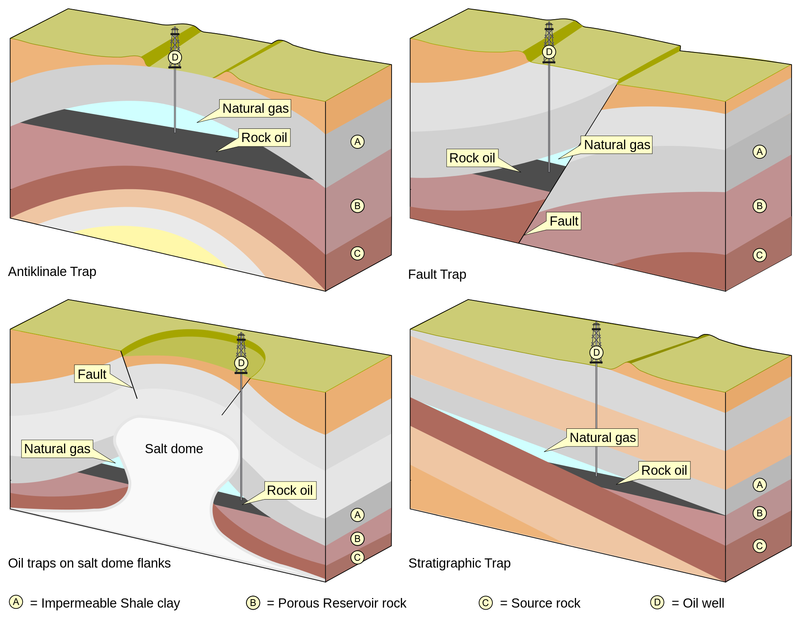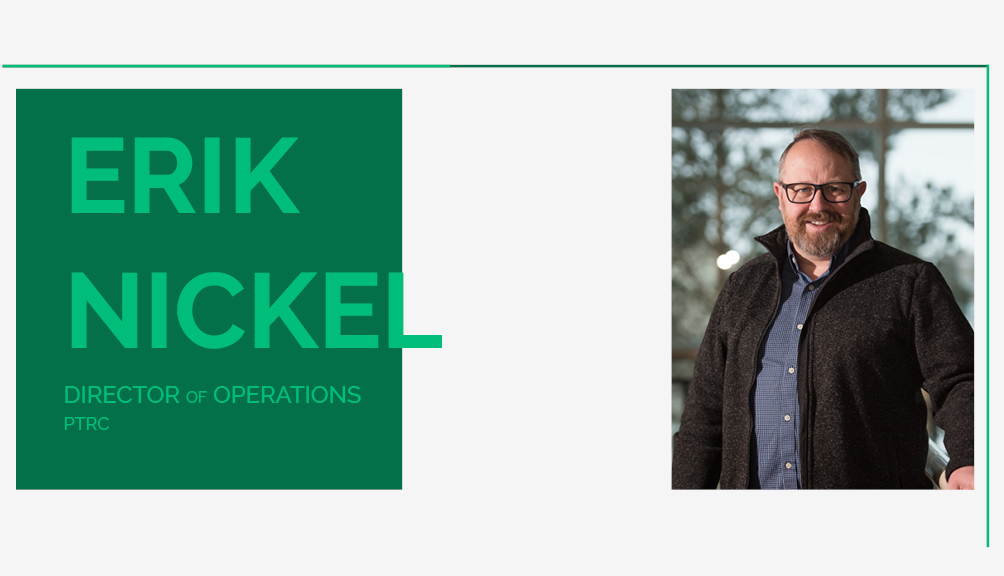New Opportunities for Oil and Gas Experts
By Erik Nickel, Director of Operations, PTRC
For years, reservoir engineering, including that taught so well at the University of Regina, was all about oil and gas, and how to maximize and optimize the production of it.
As a petroleum geologist, I have been for many years involved in similar pursuits of oil and gas, whether with industry in the 90s assisting in drilling some of the first horizontal wells in the province, or for16 years at our provincial geological survey trying to promote resource development through sound reporting of stratigraphic phenomena. My past 7 years at the PTRC has been a continual effort to apply this experience to the problems that production companies currently face, and help them to build reserves through sound science and engineering.
It is no secret that oil and gas production companies now face new challenges. Low global oil prices and, in some cases, reduction in demand and mobility, have made their positions challenging. Limits on emissions, and stricter environmental regulations serve to amplify that challenge. If the direction that some think we should go in our pursuit of “cheap, clean energy” is a line directly away from fossil fuels, is there still a place in society for the reservoir engineer, or the petroleum geologist to contribute to that shift?
So what exactly is reservoir engineering? Schlumberger, one of the world’s largest energy engineering service companies, defines it as a discipline devoted to the ultimate source of value for exploration and production (E&P) operators – the reservoir. Through reservoir modeling studies, reservoir engineers endeavor to increase hydrocarbon production and maximize exploration and production assets.
A 1965 journal article goes into more depth on the goals of the reservoir engineer. However, scientifically these goals are merely the ends - the process by which they are attained is the science. The science, at its most basic, is the study of fluid movement through subsurface porous media (rocks). Summed up in one sentence, that sounds pretty simple.
Similarly, petroleum geology as a science has some basic notions about porosity and permeability, and how those relate to the depositional processes that put those rocks there in the first place. The goal of the petroleum geologist is to find a place where there is porous rock, in a relatively elevated position, with a layer of non-porous rock above it. This space is referred to as a “trap” and there are many types and structures that can create one, but all traps share a common structure of porous rock, elevated, under non-porous rock.
In addition to the study of engineering and petroleum geology, there are many related disciplines that contribute to the study of earth sciences in Saskatchewan universities. Geophysics, or the study of imaging the subsurface seismically or electrically, is an important contributor to subsurface understanding. Geotstatistics, such as the Kriging Gausian sequential process, combine geologic concepts with complex mathematics in order to figure out the best way to represent the often sparse subsurface data that we have into a meaningful final product that can be visualized and interpreted by earth scientists.

Image depicting the nature of a typical oil trap in block diagram view (reference).
The skills needed to fully understand all of these things are specific and gained through intense schooling, and usually years of work experience in the oil and gas industry. However, with energy production changing, is there still a need to teach these concepts in schools? Or will the reservoir engineer or the petroleum geologist go the way of the blacksmith or lamplighter?
While paradigms constantly change across many industries and in the larger energy development sector in general, there is and will always be a need for people who understand the subsurface movement of fluids, and the rocks within which they move. The need to supply energy is a constant, regardless of political, environmental or other motivations. It is clear that in Canada, in order to survive in our cold country, and thrive within the vast distances that separate us, energy will always be required. For years this has meant that we must exploit and use our natural resources, and for years this meant mostly oil and gas. This is unlikely to change quickly in the near future, but it is clear there is a tectonic shift slowly rumbling through the industry. Efficiently finding better ways of doing things has become paramount in sustaining not only the energy industry, but our way of life in Canada. At the PTRC we are looking at ways of producing more oil, reducing the corresponding environmental footprint, and mitigating emissions all at the same time. It can be done, but requires the hard work and investment of a lot of smart people.
This tectonic shift affects more than just the oil industry. The race is on, and has been on for some time to find the “next” energy source that will be able to replace oil and gas while still maintaining our way of life. Things like hydrogen, lithium, and geothermal, have become common conversations in Saskatchewan when looking to find our next sustaining fuel sources. What do all of these have in common? In order to exploit them efficiently and cleanly, it requires a detailed understanding of the earth’s subsurface.
Hydrogen has often been considered a perfect fuel. It packs an energy wallop in a small package, with the only emissions being water. Sounds too good to be true? Perhaps, but there are significant challenges in finding ways of creating hydrogen that are “energy balanced”. One can use renewable energy to hydrolyze water into its base components to create “green hydrogen”; however, this process uses more energy than is gained from the final product. Not the level of efficiency we are looking for, nor the best use of limited renewable energy sources. The process is not “energy balanced”.
Breaking hydrogen out of produced hydrocarbons (oil and gas) is much more efficient and requires less energy, but the process produces a nasty bi-product, carbon dioxide (CO2). Hydrogen produced this way is referred to as “grey hydrogen”. If the produced CO2 is then collected and disposed of into deep geologic formations as part of the overall “hydrogen-from-hydrocarbons-process with carbon capture and storage (CCS)”, then the produced hydrogen is referred to as “blue hydrogen”.
The latest technology being studied involves breaking the hydrogen out of the hydrocarbons while the oil and gas (hydrocarbons) are still in their natural state in the reservoirs deep underground and then separating and exclusively producing the hydrogen. In this way the CO2 bi-product is left in its original reservoir and is never emitted to the surface.
As we know, the domain of the “subsurface” is that of the reservoir engineer and petroleum geologist, even when it comes to in-situ hydrogen production, or the CCS that is required for blue hydrogen production.

Image depicting the 3 main types of hydrogen that can be produced, and the considerations for each of them (reference).
Lithium is the main component in the newest and best battery technology we have, and is agreed to be crucial in facilitating a shift to mobile electricity usage. From cars to better electronics, we are dependent upon the production of lithium. Recently, companies have sprung up, including in Saskatchewan, to exploit our lithium resources. Lithium exists here as a dissolved ion in produced water from normal oil field practices. The Saskatchewan Geological Survey has been studying the presence of lithium (and other potentially economic ions) in oilfield brines for decades, but only now does it seem to have a definite future. This energy source was delineated, quantified, and is now being exploited by people with expertise in the way fluids move deep underground. That means reservoir engineers and petroleum geologists … notice a trend yet?
Lately in the news, especially in Saskatchewan, we see a lot about geothermal energy. Deep Earth Energy Production (DEEP Corp) has a project in Southeast Saskatchewan that, thus far, looks very promising for another source of energy. This type of geothermal is not to be confused with what may be installed at a private home, with pipes laid underground below the frost line to provide warmer water via a heat pump in winter. The DEEP project is “deep geothermal”, which means drilling wells to great depths (in this case 3.5 kilometers) and extracting fluid from the saline aquifers deep underground, extracting the heat from it, and putting the briny water back down to recycle through the reservoir. In the mid-70’s, such a well was drilled at the U of R with an eye on heating the campus buildings. At the time, only one well was drilled, as costs showed it unlikely to be economic at that time. Times are different now, and priorities have shifted.

DEEP’s wells circulate the hot brine, up from 3.5 km underground, and then back down once its heat has been utilized (photo courtesy DEEP).
The DEEP Corp project could signal a new way to not only provide energy, but keep local oilfield service companies and their personnel working and contributing at a time when oil and gas is transitioning and challenged by world markets. The DEEP project uses many of the same technologies employed for decades in Saskatchewan oil fields. Activities like drilling, coring, logging, cementing casing, and hydraulic stimulation – all common to the oilfield for years – have all been employed in this new search for clean energy. The company was able to successfully do this because of the expertise developed by years of hydrocarbon exploration and development. All run by – you know who – reservoir engineers and petroleum geologists.
Carbon capture and storage, or CCS, is and will always be an important part of every jurisdiction’s GHG mitigation program. The IPCC in their most recent report lists CCS as one of the only ways that we, globally, will meet the Paris Accord targets. In Saskatchewan, we got into the CCS game early, and have built a wealth of knowledge and experience around it. That experience developed at places like the PTRC and the research institutions we support, makes us ready, willing, and able to take CCS to the next level in the province. Boundary Dam, after some initial start-up issues, has shown to be a great and steady producer of CO2 for both Whitecap’s Weyburn field, and the Aquistore well run by the PTRC. Those two projects, Weyburn and Aquistore, have put Saskatchewan among the global leaders in the work of CCS. Many in the world are studying CCS as a hypothetical; in Saskatchewan, we actually do it, and we do it very well, thanks again to petroleum geologists, reservoir engineers, and the supporting technologies developed right here in our home province.

The IPCC issued a special report on CCS in 2018 that highlights the critical role it must play in reaching emissions reduction targets.
Energy is changing, and the way we use it will also change. In a future where emissions are more important as we march toward “net zero by 2050”, the move away from oil and gas is an inevitable yet gradual transition. For those of us working in the technologies that enabled oil and gas for so long, those same skills with a different aim will always be required, especially in Saskatchewan. Beyond the engineers and geologists, the service companies that thrived under busy oil and gas work have the potential to now add geothermal, lithium, hydrogen, or CCS to their portfolios, and Saskatchewan has all of these things in abundance. There are also additional subsurface resources to be discovered and that are available deep underground in Saskatchewan, including helium.
All of this is to say that I believe, as a petroleum geologist and manager of programs in these sorts of technologies, the future, once murky, now looks pretty bright. The use of hydrocarbons will continue; they will be extracted more carefully and used more efficiently than they have in the past. Add to the mix, the expertise needed to expand hydrogen, lithium, geothermal, and CCS, and the knowledge required to know the subsurface in ways that will always be needed grows with each passing day. While the universities that teach these programs, the service companies that run these technologies, and the energy companies that drive the province may have to change their strategies and messages, the core competencies that they need in order to be successful remain the same.
Acknowledgements
Thanks to our partners and colleagues for allowing us to link to their sites, including the International CCS Knowledge Centre, Deep Earth Energy Production (DEEP), the International Panel on Climate Change, the Government of Saskatchewan, and the University of Regina. Credit also to websites and companies as indicated in this Blog.


